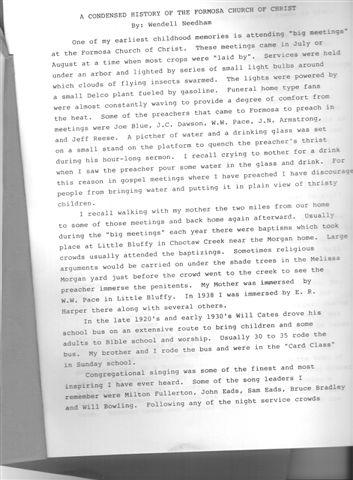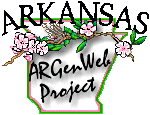History of Formosa Church of Christ
by Wendell NeedhamSubmitted by Alice Burroughs Shipley
 One of my earliest childhood memories is attending "big meetings" at the Formosa Church of Christ. These meetings
came in July or August at a time when most crops were "laid by". Services were held under an arbor and lighted by series
of small light bulbs around which clouds of flying insects swarmed. The lights were powered by a small Delco plant
fueled by gasoline. Funeral home type fans were almost constantly waving to provide a degree of comfort from the heat.
Some of the preachers that came to Formosa to preach in meetings were Joe Blue, J.C. Dawson, W.W. Pace, J.N. Armstrong
and Jeff Reese. A picther of water and a drinking glass was set on a small stand on the platform to quench the
preacher's thrist during his hour-long sermon. I recall crying to mother for a drink when I saw the preacher pour some
water in the glass and drink. For this reason in gospel meetings where I have preached I have discouraged people from
bringing water and putting it in plain view of thristy children.
One of my earliest childhood memories is attending "big meetings" at the Formosa Church of Christ. These meetings
came in July or August at a time when most crops were "laid by". Services were held under an arbor and lighted by series
of small light bulbs around which clouds of flying insects swarmed. The lights were powered by a small Delco plant
fueled by gasoline. Funeral home type fans were almost constantly waving to provide a degree of comfort from the heat.
Some of the preachers that came to Formosa to preach in meetings were Joe Blue, J.C. Dawson, W.W. Pace, J.N. Armstrong
and Jeff Reese. A picther of water and a drinking glass was set on a small stand on the platform to quench the
preacher's thrist during his hour-long sermon. I recall crying to mother for a drink when I saw the preacher pour some
water in the glass and drink. For this reason in gospel meetings where I have preached I have discouraged people from
bringing water and putting it in plain view of thristy children.
I recall walking with my mother the two miles from our home to some of those meetings and back home again afterward. Usually during the "big meetings" each year there were baptisms which took place at Little Bluffy in Choctaw Creek near the Morgan home. Large crowds usually attended the baptizings. Sometimes religious arguments would be carried on under the shade trees in the Melissa Morgan yard just before the crowd went to the creek to see the preacher immerse the penitents. My Mother was immersed by W.W. Pace in Little Bluffy. In 1930 I was immersed by E.R. Harper there along with several others.
In the late 1920's and early 1930's Will Cates drove his school bus on an extensive route to bring children and some adults to Bible school and worship. Usually 30 to 35 rode the bus. My brother and I rode the bus and were in the "Card Class" in Sunday school.
Congregational singing was some of the finest and most inspiring I have ever heard. Some of the song leaders I remember were Milton Fullerton, John Eads, Sam Eads, Bruce Bradley and Will Bowling. Following any of the night service crowds of young people, mostly teenagers, walked the dusty roads to their homes, many times in the dark.
Through the years I have gleaned from older people and some sketchy records that the Formosa church dates back to 1874. Some families from Hardeman County, Tennessee, migrated to Arkansas and settled in the Formosa Community. Among these families were Bowlings and Webbs. A small meeting house was erected near Bowling Springs where a few families worshiped. By 1900 several families met regularly, and decided to begin meeting in a one-room school building at Slick Rock, more than two miles from Formosa. In 1906 a tornado destroyed the school building. No record is available as to where the church met for the next four years, but in 1910 a one room building, lighted by Aladin-type kerosene lamps which hung down from the ceiling, and poorly heated by a small wood stove in the center of the room, was erected just to the southwest of the present building and almost directly across the road from the old two-story school building. Donald Morgan drove a wagon and team to Little Rock and brought back the old church bell that is still seen in the bell tower of the new building.
Some of the charter members of the Formosa church at the new location were Milton and Kate Fullerton, Donald and Melissa Morgan, John and Martha Webb, Earlie and Elvie Webb, Cletis Webb, Verla Webb, Orla Webb, and Oather Webb, Will and Lyda Aovenshine, Will Honeycutt, Dr. and Mrs. Daniel J. Halbrook, S.M. Bowman, Gila Cates, F.M. Jones, H.C. and Ida Jones, Tom and Exie Bowling, Mr. & Mrs. Imos Bowling, Mr. and Mrs. Jim Bowling, Mr. & Mrs. Joe Bowling, Elizabeth Hammett, Sara Ann Bowling, T.B. Farley, Joanna Farley, Artie Pavatt, Minnie Bradley, Mrs. S.E. Malbrook. I was privileged to know more than half of the charter members in later years. The Dave Eads family came later.
Preaching usually was by men who came once a month. The preachers came on a Saturday and spent the night in the home of some of the members. They also were invited to eat Sunday dinner with the host family. A very humerous incident concerning a visiting preacher named Green was related to me by Sister John Webb. Brother Green was invited to eat Sunday dinner with the Webb's. According to Sister Webb, Brother Green had the largest nose she had ever seen. She was facinated by it and caught herself staring at it. Among other vegetables Sister Webb had turnip greens for dinner. The usual hospitable gesture following the giving thanks for the food was the invitation. "Just make a long arm and reach and help yourself." Sister Webb, still staring at the preacher's long nose, urged him, "Just make a long nose and reach and help yourself to the greens Brother Green!"
Gospel meetings usually were conducted under an arbor just outside the front of the building. The benches were brought outside and arranged in two sections under the arbor. I was privileged to preach in some meetings under the arbor. People would fill up the seats first, and several would sit on truck beds and on the ground. Babies and small children would be placed on pallets on the gound under the watchful eye of the mothers. Gospel meetings were well-attended in those days and most times lasted from 10 days to 2 weeks.
Through the years several good men have served as elders of the church. Among those that I have a record of were Milton Fullerton, Donald Morgan, Tom Eads, Willie Lowe, Bruce Bradley, Homer Jones and Erwin Olinger. Several who served as decons were Joe Bowling, Andy Bradley, John Eads, Ray Morgan, Will Bowling, Cletis Webb, Arlie Lowe, Homer Jones, Austin Sanger, Dick Bowling and Olen Williams. Otho Holloway was selected as deacon but died shortly afterward.
In the 1920's a number of improvements were made on the meeting house of the church. A Delco plant, fueled by gasoline, was purchased to provide power for lighting, and was used until electricity came into the area when flourescent lights were installed. A few years later central heat and air, two classrooms, rest rooms and a baptistry were added.
It has been my pleasure to preach in 15 gospel meetings for the Formosa church. The earlier meetings in the 1940's had both day and night services and later on vacation Bible schools were conducted in the daytime.

